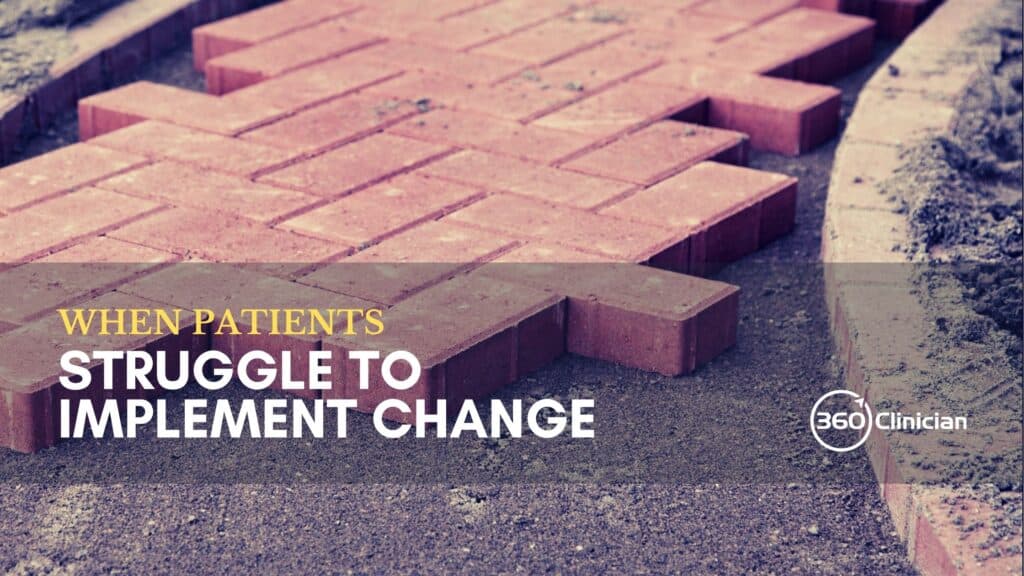Making personal health changes can be hard.
Starting an exercise program can be hard.
Reframing beliefs about our body and pain can be hard.
These can be hard things to do.
Yet, we ask our patients to do all of these things when they come for physiotherapy.
Patients can come to physiotherapy feeling frustrated and demoralized because of ongoing pain. They may share how they’ve tried various strategies in the past with little change.
And they’re now sitting in front of you. While our goal is to identify the underlying problems with a thorough assessment, we have another task all together different that we need to solve.
And that is helping our patients make positive personal changes in their bodies and lives.
It’s not at all uncommon for patients to struggle with making changes. And it’s easy to think of their hesitancy or resistance to change, as laziness or lack of motivation. However, there’s something deeper going on with our patients – a reason why change might be so hard for them.
In this blog post I share what these reasons are and how we as physical therapists can better help our patients implement change in their lives!
Emotional Energy Matters
It takes energy to create change in our life.
Making personal and health changes can feel hard, especially when life is busy and stressful.
When a patient is in pain or deprived of their usual energy-giving activities, anything that requires emotional exertion may mean even less emotional energy.
There’s a great quote from the book “The Switch” where the authors highlight the impact on our self-control (aka motivation) when making a change:
The bigger the change you’re suggesting, the more it will sap people’s self-control. And when people exhaust their self-control, what they’re exhausting are the mental muscles needed to think creatively, to focus, to inhibit their impulses, and to persist in the face of frustration or failure.
In other words, they’re exhausting precisely the mental muscles needed to make a big change.
Patients may not always have the energy necessary to enact positive changes that we are asking as physiotherapists. They may be experiencing significant stress in their job, family life, or chronic pain so it makes it impossible for them to better themselves. As physiotherapists, this is something important to recognize in our patients. We can then help and guide them along the best path of recovery given their current capacity.
Are Patients Ready to Make Changes?
It’s important to look at a patient’s capacity for change.
It is never a good idea to ask a patient to make too many changes in their life.
Overwhelming the patient can backfire and make them less likely to successfully implement the changes you request. It can also backfire for you as the physiotherapist since progress will often stall and you may encounter resistance from your patient.
Patients may come to us believing they’re ready for physiotherapy and for embarking on home exercises, lifestyle changes etc. But they may not recognize the energy that the change and new behaviours require.
As physiotherapists, we need to pay attention to our patients’ present state and identify the availability of their “change resources”.
We may interpret their lack of change as resistance or laziness, but perhaps we need to take a step back and ask ourselves if this patient is ready to progress.
How Do We Know if Patients are Ready for Change?
So a question you may have is , “How do I know if my patient is ready?”
One way to think about readiness is in terms of the resources a person has available for making change. Resources can include: energy, time and motivation.
If any one resource feels low then it’s important to question whether the patient will be successful at implementing changes now or later.
Patients provide hints about their readiness for change in many ways. Just some of the clues they may give are:
- They mention their lack of time and their level of stress in life
- They may mention their level of fatigue and overall energy level
- They may highlight the difficulties with sleep, decreased physical activity or lack of social supports.
By listening to these clues, we can start to suss out possible energy drains patients may be experiencing.
How to Make Change Easier for Patients
Since change requires energy and energy can be in short supply it’s important to guide your patient to make them successful early in their treatment.
A simple strategy is to set a small goal for your patient that you and they are confident can be achieved. This will boost their confidence and make them feel successful early on in their treatment. When change feels good, it makes it easier to continue and build on.
There’s often a tendency as physiotherapists to link the value we provide to the number of exercises we provide or amount of education given. By resisting this urge, and giving less, we can actually increase our patient’s ability to tackle the change they need to do and build momentum in their recovery.
The Physiotherapist’s Role in Care
Our role as physiotherapists is to work together with our patients and figure out what they might need at this time. We can help them identify resistance that they have about making changes, modify our treatment approach or offer coaching to help them find new ways bring new energy into their lives!
Here’s the Bottom Line
The bottom line is that change is hard.
Changing personal routines, adding a home exercise program, refraining from aggravating activities and attending physiotherapy sessions can all take energy.
Identifying the change capacity your patient has can help you avoid patient drop off and help them make the changes they need.
To better flow,
Andrew
If you enjoyed this article and want to stay up-to-date on my newest content, sign up for the Clinical Flow Newsletter! There you will have access to special offers, exclusive content, and be part of a growing community of clinicians with the purpose of improving yourself and your clinical practice.


